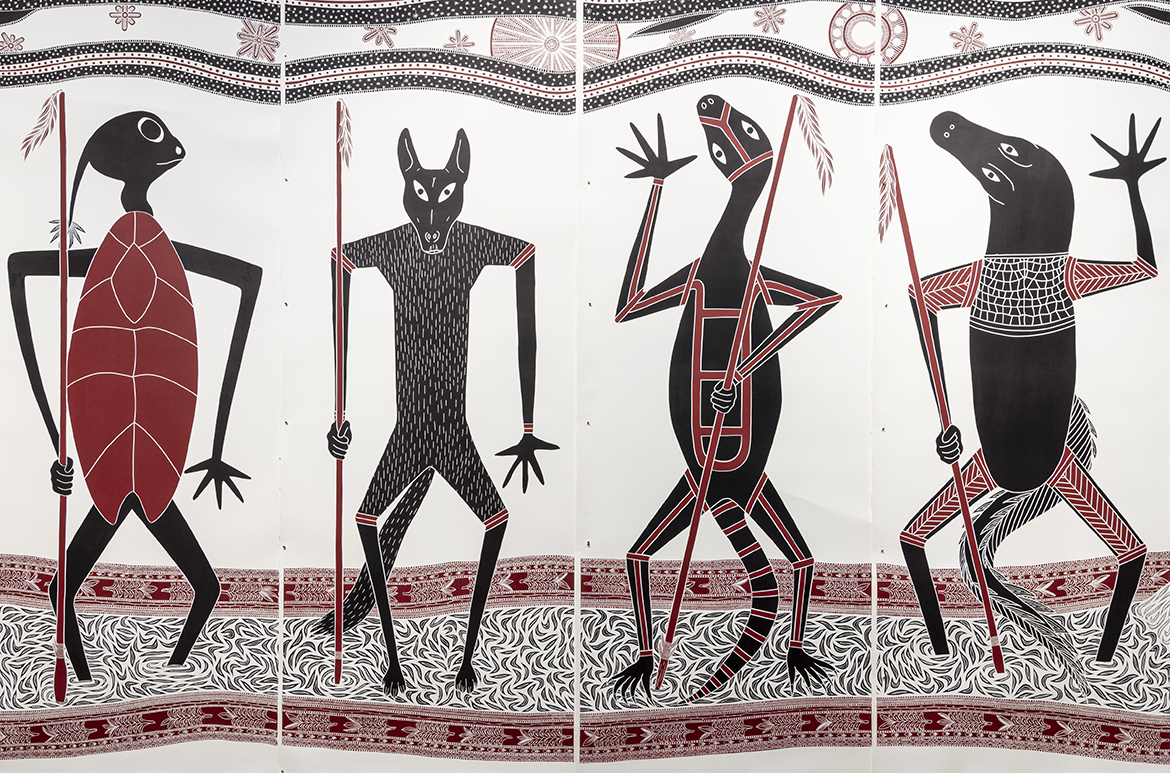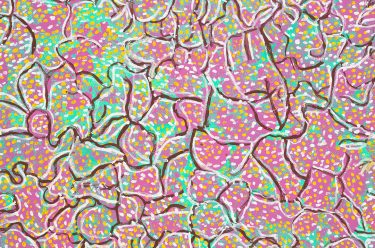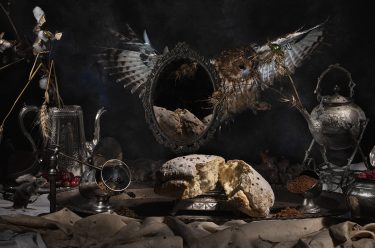The 2023 QAGOMA Foundation Appeal will this year support the acquisition of major works by Queensland Indigenous artists, beginning with Judy Watson, Teho Ropeyarn, and Brian Robinson in collaboration with emerging artist Tamika Grant‑Iramu. Here, we share insights into the works and their makers.
Three works lead this year’s Appeal. An impressive sense of scale immediately brings them together, but they are connected in far greater measure by the Queensland Indigenous histories, localities, and landscapes that they represent. Additionally, the artists have emphasised water as an enduring Indigenous resource, understood not only for its cultural and spiritual significance but also as a patently Queensland element: certain in a state flanked by coastal islands, lined in rainforests, snaked by rivers, and often drowned by floods.
Judy Watson
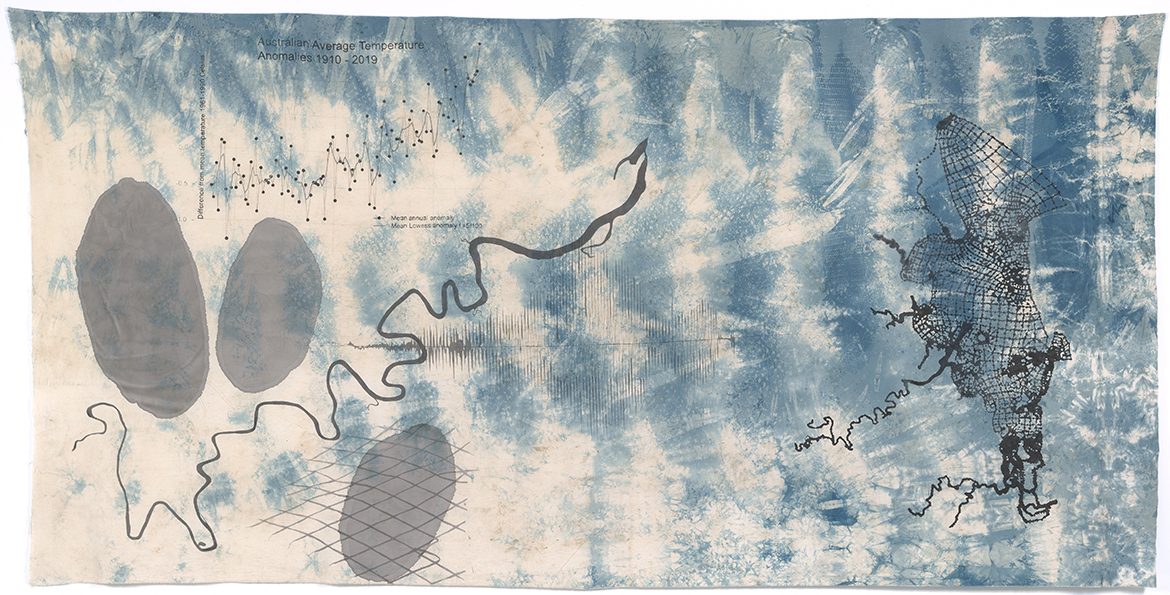
Delving deep into Queensland’s watery undercurrents, senior Waanyi artist Judy Watson surveys the steady creep of climate change in her painting moreton bay rivers, australian temperature chart, freshwater mussels, net, spectrogram 2022 (illustrated). In this work, a bird’s eye view of Moreton Bay and its rivers are overlaid with a chart of Australia’s average air and water temperatures recorded between 1910 and 2019, tracking a worrying creep in warming. Watson integrated this scientific data alongside the knowledges of Indigenous women and others close to her. With her non-Indigenous niece-in-law and artist Tor Maclean, Watson experimented with eco-dying and stencilling images of spectrograms. Meanwhile, Aunty Helena Gulash spoke Kabi Kabi words, collected here in the form of spectrograms. At Watson’s mother Joyce’s house, the artist painted these spectrograms, while at her cousin Dorothy’s home in Oxley — in view of the flood-prone Oxley Creek — she dyed the work in indigo. The artist later added the map of Moreton Bay and its rivers, and three freshwater mussel shells known as malu malu in Waanyi language. By carrying the residue of mapped Country (specifically, the peoples of and connected to the region), transforming the sound of breath into a spectrogram, and plotting scientific charts, Watson reminds us poignantly of climate change’s existential threat in south‑east Queensland.
Teho Ropeyarn

Following another existential theme, in Teho Ropeyarn’s epic Athumu Paypa Adthinhuunamu (my birth certificate) 2022, the Angkamuthi/Yadhaykana artist explores Injinoo creational and cosmological beliefs, emphasising water as a deeply personal material, cultural and spiritual resource. Across six panels, Ropeyarn depicts the four totemic creatures of Injinoo (on the north-western coast of Cape York Peninsula), who each represent one of the four clans: Uyinthayn/Uwinthyn (freshwater turtle) of the Ankgamuthi Nation; Akaymu/Utaga (dingo) of the Atambaya Nation; Urruvu (goanna) of the Gudang Nation; and Ikamba/Ikambala (crocodile) of the Yadhaykana Nation. The totemic creatures are enclosed within a pool of water — here taken to represent Queensland’s longest perennial system, the Jardine River — by two great carpet snakes, known as Umbah, who formed the Great Dividing Range by digging for water. The head waters of the Jardine fall from a low-lying plateau within the Dividing Range that gives the appearance of a snake’s head, its eyes being the waterfall cliffs that flow to the river mouth. Water here surges as a creational element that simultaneously links the physical, natural and spiritual realms. As the artist has stated,
my work explains how the land becomes the human, the human becomes the animal, the animal becomes the land, the land becomes the spirit, and the spirit becomes a device linking these elements.1
Ropeyarn’s largest work to date, this tableau expertly narrates the creational foundations of Injinoo. In such a way and, as the work’s title suggests, this is the artist’s birth certificate: a visual document of sorts that highlights the holism of Aboriginal belief, which integrates all modes of life into a simultaneous worldview.
Brian Robinson and Tamika Grant-Iramu
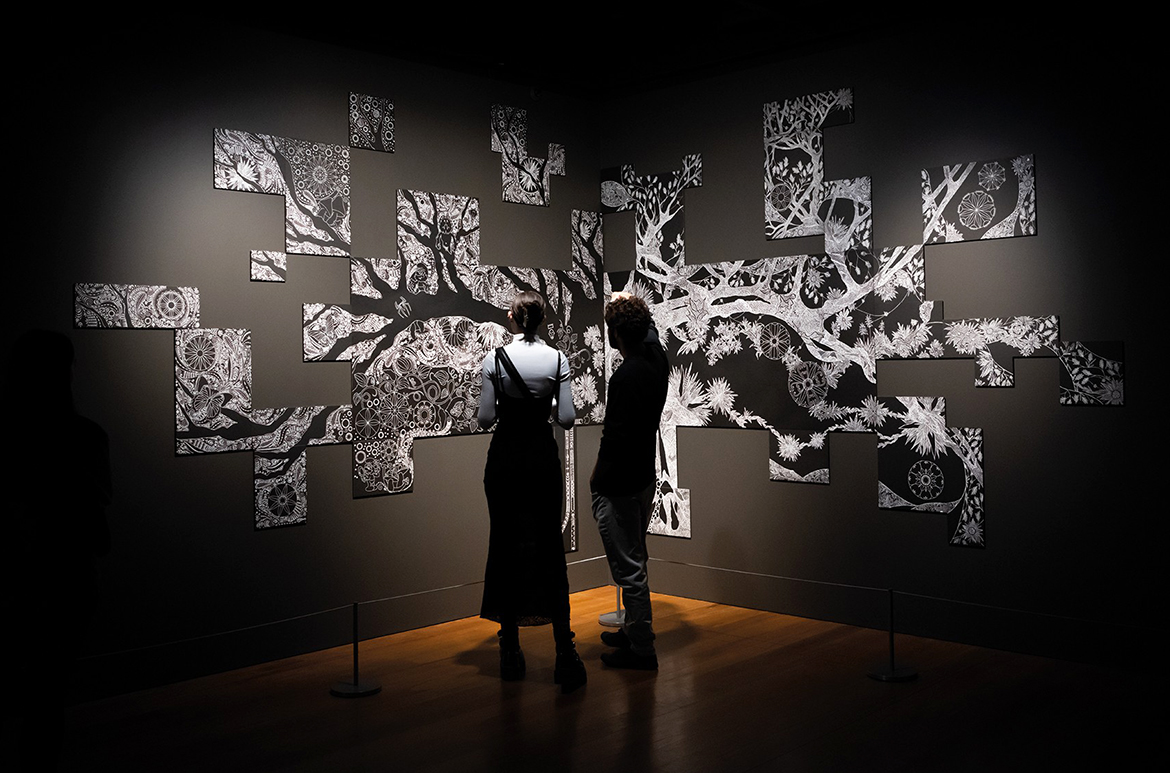
Another colossal example of printmaking — the intergenerational collaboration Carving Country 2019–21 — links the practices of senior Maluyligal/Wuthathi/Dayak artist Brian Robinson and emerging Brisbane‑based artist Tamika Grant-Iramu, who has Torres Strait Islander and Papua New Guinean heritage. Comprised of 37 printed blocks, the work takes the form of a sprawling jacaranda tree. Attesting to the dialogue formed between the artists’ practices and carving styles, the jacaranda is split into positive and negative sections: Robinson commanding the black negative space, and Grant-Iramu balancing its white positive inverse. Robinson’s half of the tree is replete with pop-culture artefacts and ephemera, including Papa Smurf, Pac Man and the Spiderman logo. He integrates these icons into a hybrid cross-cultural landscape encumbered by Torres Strait minaral designs that are demonstrably looser than Grant‑Iramu’s half of the tree, which is ornately compacted and complements Robinson’s minaral designs with ‘starburst’ florals. The subtle interplay between the two artists — where salt and freshwaters meet — ripples in a sweet harmony, with coiling branches, falling flowers, the sea and the sky converging in a most brilliant show of Country.
The support of the 2023 Foundation Appeal in bringing these important works into the Collection reflects the commitment the Gallery has made to prioritising the acquisition of works by Queensland Indigenous artists, whose contribution to the arts ecology — not only of Queensland but also across Australia — cannot be overstated. The three works mentioned here are enduring examples of the talent and strong cultural connections artists have and maintain across the state, from Brisbane to the Cape to the Torres Strait.
Until 3 September, visitors to the Queensland Art Gallery can view Teho Ropeyarn’s extraordinary work Athumu paypa adthinhuunamu (my birth certificate) 2022 in Gallery 1, while visitors to the Gallery of Modern Art can hear from all four artists in a video screening at the top of the escalators on level 2.
For more information or to make a donation, visit qagoma.qld.gov.au/2023appeal
Adam Ford (Nyoongar) is Assistant Curator, Indigenous Australian Art, QAGOMA
This article was originally published in the QAGOMA Members’ magazine, Artlines, no.2, 2023
1 Teho Ropeyarn, Artist Statement, Biennale of Sydney, 2022, https://www.biennaleofsydney.art/participants/teho‑ropeyarn/, accessed 7 March 2023.
Hear from the artists
Acknowledgment of Country
The Queensland Art Gallery | Gallery of Modern Art (QAGOMA) acknowledges the traditional custodians of the land upon which the Gallery stands in Brisbane. We pay respect to Aboriginal and Torres Strait Islander elders past and present and, in the spirit of reconciliation, acknowledge the immense creative contribution Indigenous people make to the art and culture of this country. It is customary in many Indigenous communities not to mention the name of the deceased. All such mentions and photographs on the QAGOMA Blog are with permission, however, care and discretion should be exercised.
#QAGOMA
